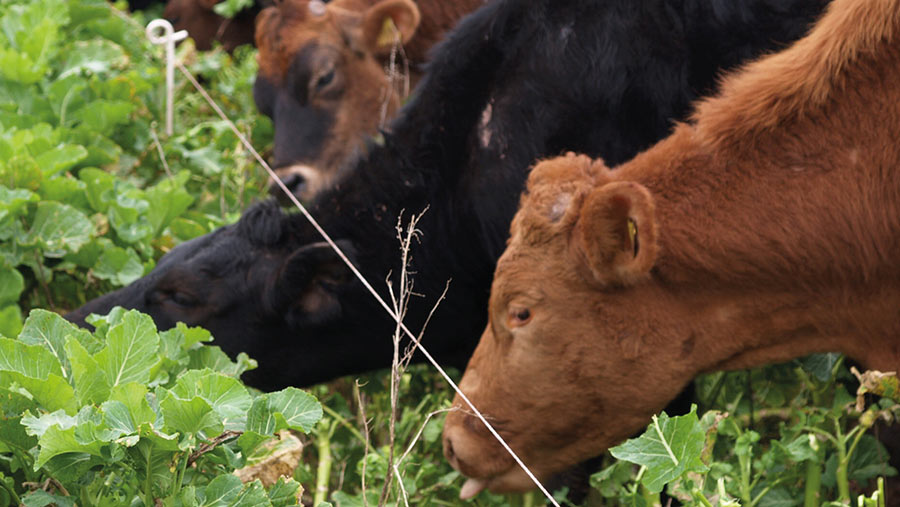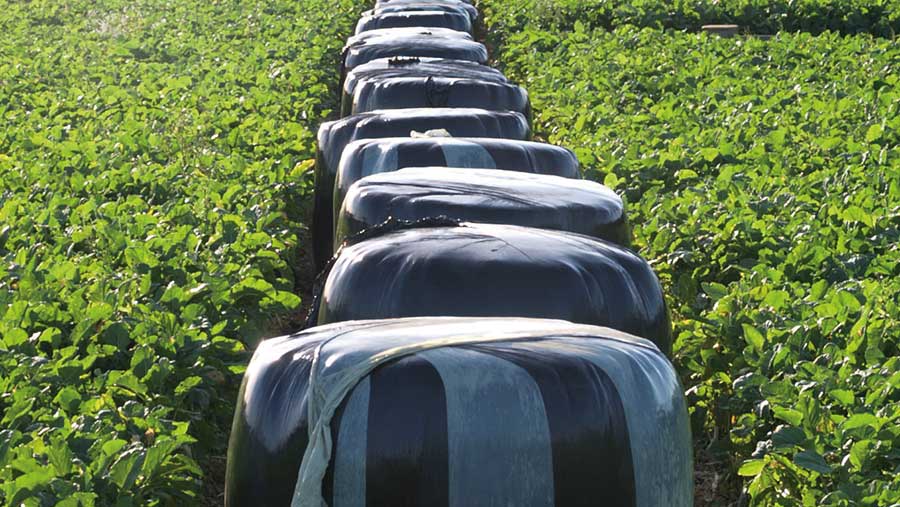Outwintering cattle on kale or grass silage: Which is best?
 © Debbie James
© Debbie James Maximising the value of forage grown on farm can increase profit margins in beef production where winter feed is often the highest variable cost.
The economics of growing a crop and its nutritional value are important considerations when working out which crop delivers the best value.
In a kale system, some silage will still need to be grown – a typical diet for cattle is based around 30% silage and 70% kale.
See also: Video: Advice on feeding fodder beet to dairy stock
Which silage is the best fit for an outwintering system?
Independent grass and forage consultant Marc Jones says kale is a good producer of high-quality feed for either dry suckler cows or cattle from 200-400kg.
At a net energy value of 1.07 units/kg of dry matter (DM), its value is the same as that of spring grass.
“Kale has earned its status as a high-quality feed due to its very good leaf-to-stem ratio,’’ says Mr Jones.
Arguably, there is less waste with silage. Even with good management, the utilisation rate for kale is typically no higher than 80%.
Therefore, this must be factored into the costings for an accurate comparison.
Kale versus silage growing costs |
||||
|
|
Total kale costs (inclusive of land rentals and depreciation) |
Kale cash costs |
Total silage costs (inclusive of land rentals and depreciation) |
Silage cash costs |
|
Cost/ha |
£499 |
£382 |
£523 |
£376 |
|
Cost/t freshweight |
£9 |
£7 |
£23 |
£16 |
|
Cost/t utilised DM |
£67 |
£51 |
£105 |
£76 |
|
Cost/MJ of metabolisable energy (ME) |
0.6p |
0.5p |
0.9p |
0.7p |
Yield is critical to the cost effectiveness of either crop – the higher the yield, the cheaper it is in kilograms of DM.
The time at which kale is sown makes a big difference to the yield and, therefore, the cost. Kale should be sown in the first fortnight of June to achieve a yield of 10t DM/ha.
If kale is sown from the beginning of July, a yield reduction of around 1t DM/week should be factored in.
Kale is generally cheaper on a cost/kg of DM basis, unless it is a poor crop. Kale costs 8-9p/kg DM, while silage costs 12-15p/kg DM.
But silage expert Dave Davies says there is often room for improvement in silage production, which then affects its value in terms of livestock growth rates.
“On systems that focus on forage production, baled silage can have a metabolisable energy (ME) of 11.5 and a crude protein (CP) of 17%,’’ he says.
Data was analysed from nearly 2,000 grass silage samples in Wales – funded through Farming Connect – between 2015-20.
It showed that beef farmers whose grass silage analysis was in the top 25% could capture daily liveweight gains of 400g a head higher than animals fed the same quantity of average quality forage.
This equated to a cost benefit of £24 a head a month.
The top 25% quality samples had an ME of 11.39 MJ/kg DM and a CP of 157g/kg DM, while for the average, the ME was 10.17 MJ/kg DM and the CP was 126g/kg DM.
Nutritional value
Outwintered cattle usually have a higher maintenance requirement – if the weather is particularly bad, growth rates can drop off significantly.
“In the end it comes down to good silage in both systems, if you have bad weather all winter and poor silage, you will be in trouble with the youngstock,’’ says Mr Jones.
Differences in nutritional quality between silage and kale, in average samples |
||
|
|
Big bale silage |
Kale |
|
DM (%) |
36 |
14-16 |
|
D value (%) |
66 |
70-75 |
|
ME MJ/kg DM |
10.5 |
10-11 |
|
CP (%) |
10.1 |
16-7 |
Which classes of cattle are best suited to each type?
All classes of stock will perform well on silage, but kale is better suited to wintering store cattle where compensatory growth at grass the following spring can be fully utilised.
Suckler cows and dry cows can also fit into the system.
As kale should make up no more than 70% of the animal’s DM intake, the daily diet for a weanling, for example, would be 6.3kg DM of kale and 2.7kg DM of silage.
Dairy youngstock and dry cows can also be grazed on kale. As a guide, a dry suckler cow will require a daily DM intake of 12kg and growing cattle, 2.5% of their bodyweight.
Outwintering on kale comes with the potential risk of iodine deficiency, so ensure cattle are supplemented with a bolus.
Does land type play a role?
Cattle won’t do well standing in mud all winter, so the right type of ground is needed for outwintering, whether it is grazing a forage crop or feeding silage bales on a sacrificed field.
Grazing kale, in particular, is only suitable on farms with low rainfall and free-draining fields. On farms with heavy soils, it is better to house cattle.
Which scores best on labour?
Both kale and feeding big bale silage in a field come with the advantage that there is no requirement for a shed and bedding and consequently there are no muck spreading costs either.
Both can be strip-grazed with electric fences, so that will take the same amount of time, but in a silage system more bales will need to be unwrapped and ring feeders moved.
However, the difference could be as little as 10 minutes a day.

Place silage bales in the field before winter grazing © Debbie James
Environmental considerations
Kale
- Direct-drilling will hold the soil together better than ploughing
- Try to grow kale in flat, free-draining fields
- Create a buffer strip of grass around the field to prevent run-off from escaping – set up an electric fence approximately 5m from the hedge around the entire perimeter of the field
- Graze from the top of a bank down so that rainwater runs through the crop first, catching any run-off
- Move the cattle daily so that they have a fresh piece of dry ground each day
- Consider back-fencing in wet conditions to prevent tracking of the field – the ground will also dry out quicker behind the cattle ready to be cultivated in the spring
- Place silage bales in the field before winter grazing to prevent compaction, rutting and water running along tractor tracks
Grass
- Similar to kale as both systems are outdoors, but placing bales in the field before winter is key
- All that will then be needed is to roll the ring feeders to the next bales and move the electric fence
